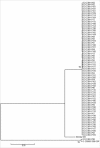Epidemiology of foodborne Norovirus outbreak in Incheon, Korea
- PMID: 20676321
- PMCID: PMC2908779
- DOI: 10.3346/jkms.2010.25.8.1128
Epidemiology of foodborne Norovirus outbreak in Incheon, Korea
Abstract
On June 14, 2008, an outbreak of gastroenteritis occurred among elementary school students in Incheon. We conducted an investigation to identify the source and described the extent of the outbreak. We performed a retrospective cohort study among students, teachers and food handlers exposed to canteen food in the elementary school. Using self-administered questionnaires we collected information on symptoms, days of canteen food eaten, food items consumed. Stool samples were collected from 131 symptomatic people and 11 food handlers. The catering kitchen was inspected and food samples were taken. Of the 1,560 people who ate canteen food, 117 were symptomatic cases, and the attack rate was 7.5%. Consumption of cucumber-crown daisy salad (RR=2.71), fresh cabbage mix (RR=2.23), dried radish salad (RR=3.04) and young radish kimchi (RR=2.52) were associated with illness. Sixty-four (45%) of the 142 stool specimens were positive for Norovirus. Norovirus was detected in 2 food handlers. Interviews with kitchen staff indicated the likelihood of contamination from an infected food handler to the dried radish salad during food processing. The excretion of Norovirus from asymptomatic food handlers may be an infection source of Norovirus outbreaks.
Keywords: Disease Outbreaks; Norovirus.
Figures


Similar articles
-
Food-borne norovirus-outbreak at a military base, Germany, 2009.BMC Infect Dis. 2010 Feb 17;10:30. doi: 10.1186/1471-2334-10-30. BMC Infect Dis. 2010. PMID: 20163705 Free PMC article.
-
A foodborne outbreak of gastroenteritis caused by Norovirus and Bacillus cereus at a university in the Shunyi District of Beijing, China 2018: a retrospective cohort study.BMC Infect Dis. 2019 Oct 29;19(1):910. doi: 10.1186/s12879-019-4570-6. BMC Infect Dis. 2019. PMID: 31664944 Free PMC article.
-
An outbreak of norovirus gastroenteritis associated with asymptomatic food handlers in Kinmen, Taiwan.BMC Public Health. 2016 May 4;16:372. doi: 10.1186/s12889-016-3046-5. BMC Public Health. 2016. PMID: 27143036 Free PMC article.
-
Foodborne and Food-Handler Norovirus Outbreaks: A Systematic Review.Foodborne Pathog Dis. 2018 Oct;15(10):589-597. doi: 10.1089/fpd.2018.2452. Epub 2018 Aug 15. Foodborne Pathog Dis. 2018. PMID: 30109958 Free PMC article.
-
The scenario of norovirus contamination in food and food handlers.J Microbiol Biotechnol. 2010 Feb;20(2):229-37. J Microbiol Biotechnol. 2010. PMID: 20208424 Review.
Cited by
-
Norovirus infections in asymptomatic food handlers in elementary schools without norovirus outbreaks in some regions of Incheon, Korea.J Korean Med Sci. 2011 Jun;26(6):734-9. doi: 10.3346/jkms.2011.26.6.734. Epub 2011 May 18. J Korean Med Sci. 2011. PMID: 21655057 Free PMC article.
-
Possible Internalization of an Enterovirus in Hydroponically Grown Lettuce.Int J Environ Res Public Health. 2015 Jul 17;12(7):8214-27. doi: 10.3390/ijerph120708214. Int J Environ Res Public Health. 2015. PMID: 26193291 Free PMC article.
-
How Long Do Microorganisms Survive and Persist in Food? A Systematic Review.Microorganisms. 2025 Apr 14;13(4):901. doi: 10.3390/microorganisms13040901. Microorganisms. 2025. PMID: 40284737 Free PMC article. Review.
-
Complete sequence analysis of human norovirus GII.17 detected in South Korea.Epidemiol Infect. 2019 Jan;147:e203. doi: 10.1017/S0950268819000943. Epidemiol Infect. 2019. PMID: 31364537 Free PMC article.
-
Acute gastroenteritis outbreaks associated with ground-waterborne norovirus in South Korea during 2008-2012.Epidemiol Infect. 2014 Dec;142(12):2604-9. doi: 10.1017/S0950268814000247. Epub 2014 Feb 13. Epidemiol Infect. 2014. PMID: 24534556 Free PMC article.
References
-
- Rockx B, De Wit M, Vennema H, Vinje J, De Bruin E, Van Duynhoven Y, Koopmans M. Natural history of human calicivirus infection: a prospective cohort study. Clin Infect Dis. 2002;35:246–253. - PubMed
-
- Parashar U, Quiroz ES, Mounts AW, Monroe SS, Fankhauser RL, Ando T, Noel JS, Bulens SN, Beard SR, Li JF, Bresee JS, Glass RI. "Norwalk-like viruses." Public health consequences and outbreak management. MMWR Recomm Rep. 2001;50:1–17. - PubMed
MeSH terms
LinkOut - more resources
Full Text Sources
Medical
Research Materials

